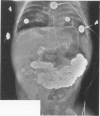Abstract
One hundred ten infants with congenital diaphragmatic hernia (CDH) developed life-threatening respiratory distress in the first 6 hours of life. Associated anomalies were present in 33%. Twenty-eight of 65 infants (43%) treated before 1987 (pre-extracorporeal membrane oxygenation [ECMO] era) survived after immediate CDH repair, and mechanical ventilation with or without pharmacologic support. Only two of 16 (12.5%) infants requiring a prosthetic diaphragmatic patch survived. Since 1987, 31 of 46 (67.4%) infants with birth weight, gestational age, and severity of illness similar to the pre-1987 group survived. All patients were immediately intubated and ventilated. Seven (four with lethal chromosomal anomalies) infants died before treatment, and 30 stabilized (partial pressure of carbon dioxide [PCO2] < 50; partial pressure of oxygen [PO2] > 100; pH > 7.3) and underwent delayed CDH repair at 5 to 72 hours. Fifteen did well on conventional support and survived. Fifteen infants deteriorated after operation: 11 were placed on ECMO with eight survivors, and four infants were not considered ECMO candidates. Nine babies failed to stabilize initially and were placed on ECMO before CDH repair (alveolar-arterial gradient > 600 and oxygenation index > 40), and seven survived. The overall survival rate was 80% at 3 months in this ECMO-treated group. Early mortality was due to inability to wean from ECMO (one), intracranial hemorrhage (one), liver injury (one), and pulmonary hypoplasia (one). Nine of 11 babies requiring a prosthetic patch in the post-1987 ECMO group survived (81.8%). There were three late post-ECMO deaths (3 to 18 months) of right heart failure (two) and sepsis (one). Symptomatic gastroesophageal reflux occurred in nine cases, six requiring a fundoplication in the bypass babies. Recurrent diaphragmatic hernia occurred in nine cases (five ECMO). The overall survival rate was significantly improved in the delayed repair/ECMO group (67% versus 43%; p < 0.05) and was most noticeable in infants requiring a prosthetic diaphragm (81.2% versus 12.5%; p < 0.005). These data indicate that early stabilization, delayed repair, and ECMO improve survival in high-risk CDH. Early deaths are related to pulmonary hypertension and can be reversed by ECMO.
Full text
PDF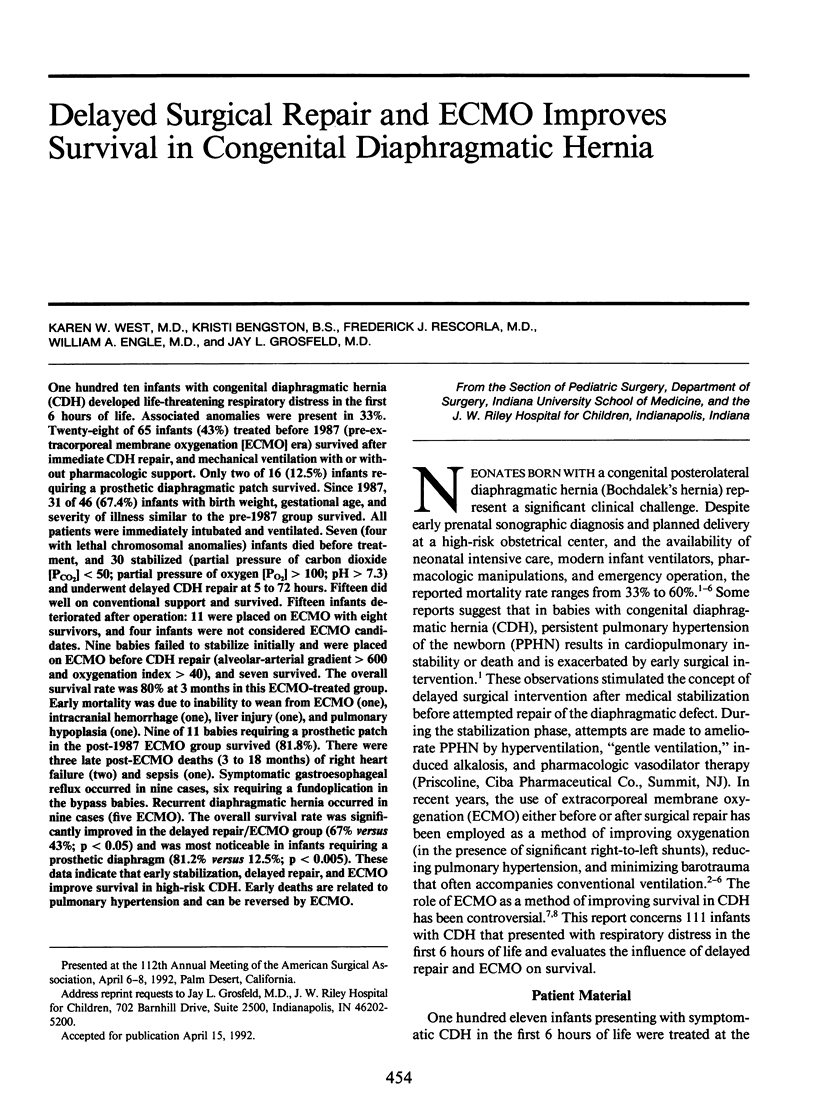
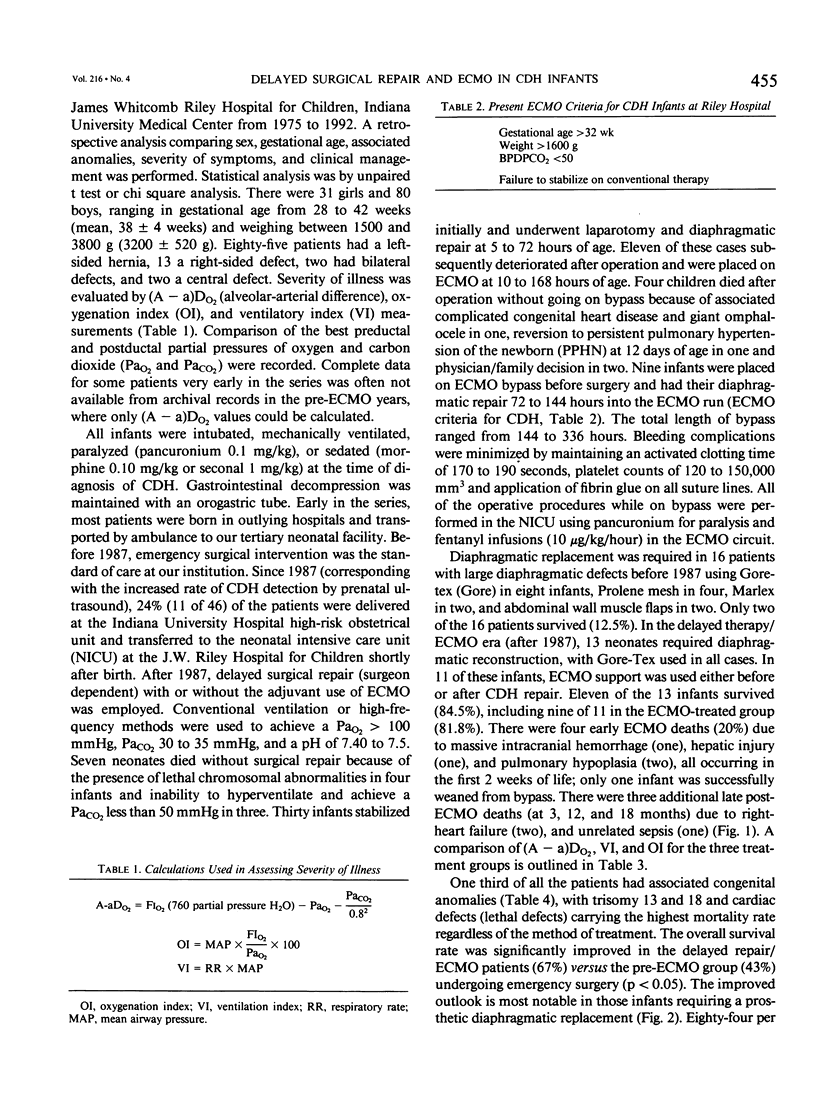
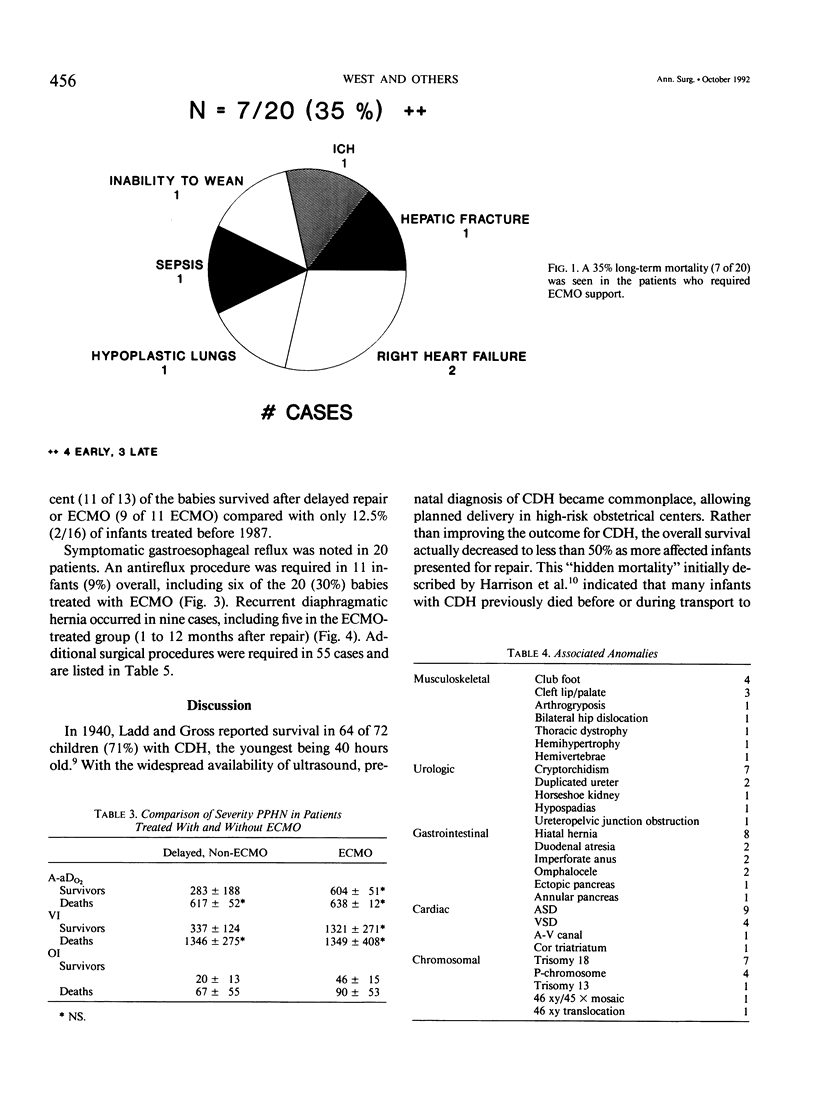
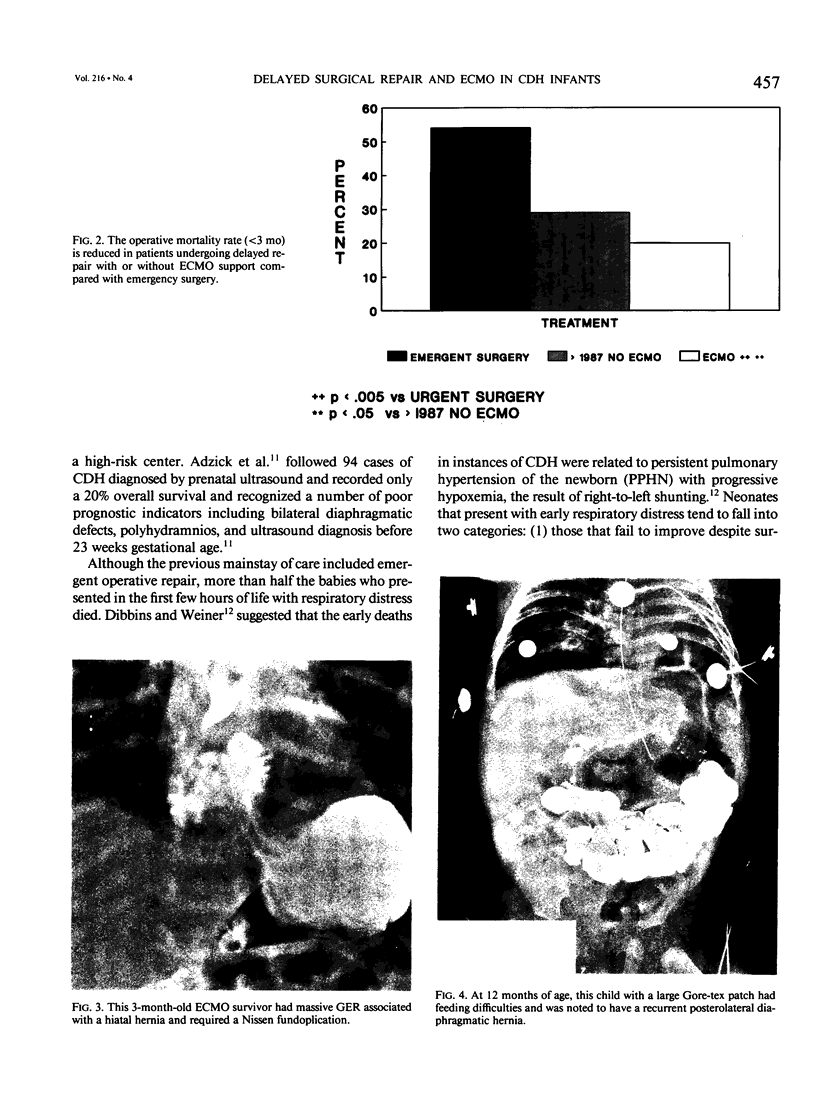
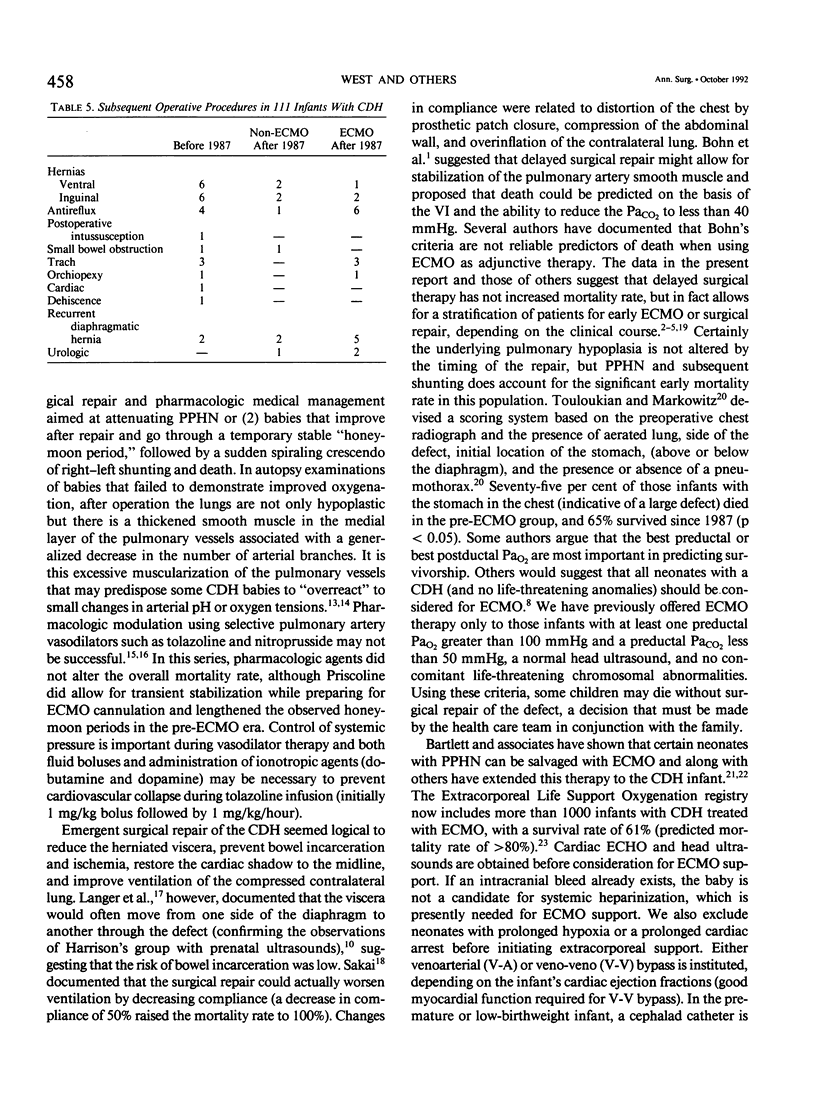
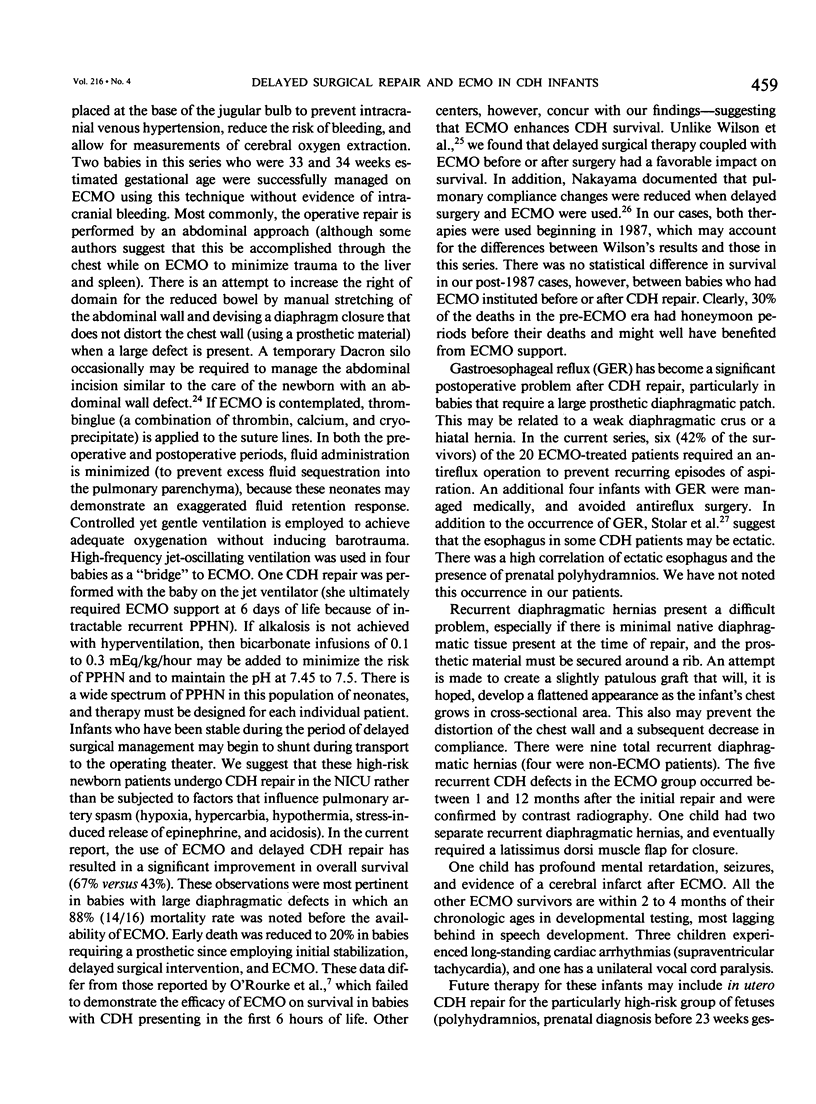
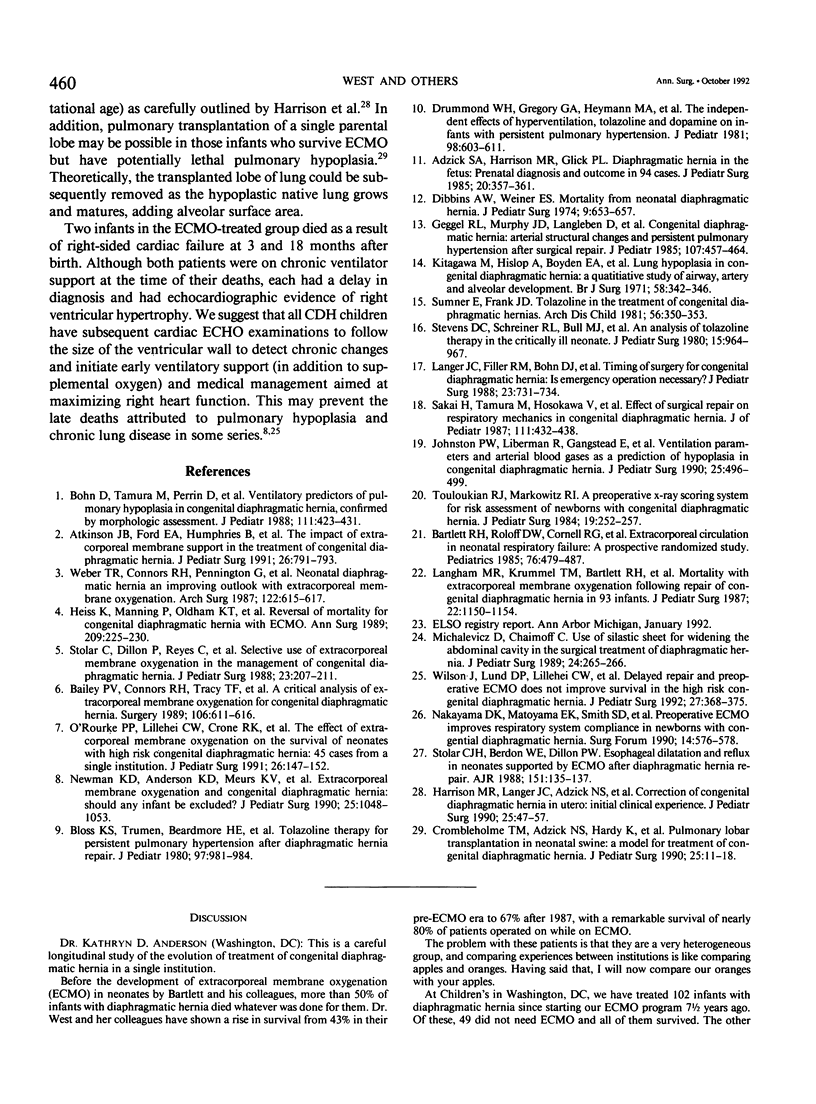
Images in this article
Selected References
These references are in PubMed. This may not be the complete list of references from this article.
- Adzick N. S., Harrison M. R., Glick P. L., Nakayama D. K., Manning F. A., deLorimier A. A. Diaphragmatic hernia in the fetus: prenatal diagnosis and outcome in 94 cases. J Pediatr Surg. 1985 Aug;20(4):357–361. doi: 10.1016/s0022-3468(85)80219-0. [DOI] [PubMed] [Google Scholar]
- Atkinson J. B., Ford E. G., Humphries B., Kitagawa H., Lew C., Garg M., Bui K. The impact of extracorporeal membrane support in the treatment of congenital diaphragmatic hernia. J Pediatr Surg. 1991 Jul;26(7):791–793. doi: 10.1016/0022-3468(91)90140-o. [DOI] [PubMed] [Google Scholar]
- Bailey P. V., Connors R. H., Tracy T. F., Jr, Stephens C., Pennington D. G., Weber T. R. A critical analysis of extracorporeal membrane oxygenation for congenital diaphragmatic hernia. Surgery. 1989 Oct;106(4):611–616. doi: 10.1097/00132586-199008000-00058. [DOI] [PubMed] [Google Scholar]
- Bartlett R. H., Roloff D. W., Cornell R. G., Andrews A. F., Dillon P. W., Zwischenberger J. B. Extracorporeal circulation in neonatal respiratory failure: a prospective randomized study. Pediatrics. 1985 Oct;76(4):479–487. [PubMed] [Google Scholar]
- Bloss R. S., Turmen T., Beardmore H. E., Aranda J. V. Tolazoline therapy for persistent pulmonary hypertension after congenital diaphragmatic hernia repair. J Pediatr. 1980 Dec;97(6):984–988. doi: 10.1016/s0022-3476(80)80441-0. [DOI] [PubMed] [Google Scholar]
- Bohn D., Tamura M., Perrin D., Barker G., Rabinovitch M. Ventilatory predictors of pulmonary hypoplasia in congenital diaphragmatic hernia, confirmed by morphologic assessment. J Pediatr. 1987 Sep;111(3):423–431. doi: 10.1016/s0022-3476(87)80474-2. [DOI] [PubMed] [Google Scholar]
- Crombleholme T. M., Adzick N. S., Hardy K., Longaker M. T., Bradley S. M., Duncan B. W., Verrier E. D., Harrison M. R. Pulmonary lobar transplantation in neonatal swine: a model for treatment of congenital diaphragmatic hernia. J Pediatr Surg. 1990 Jan;25(1):11–18. doi: 10.1016/s0022-3468(05)80156-3. [DOI] [PubMed] [Google Scholar]
- Dibbins A. W., Wiener E. S. Mortality from neonatal diaphragmatic hernia. J Pediatr Surg. 1974 Oct;9(5):653–662. doi: 10.1016/0022-3468(74)90102-x. [DOI] [PubMed] [Google Scholar]
- Drummond W. H., Gregory G. A., Heymann M. A., Phibbs R. A. The independent effects of hyperventilation, tolazoline, and dopamine on infants with persistent pulmonary hypertension. J Pediatr. 1981 Apr;98(4):603–611. doi: 10.1016/s0022-3476(81)80775-5. [DOI] [PubMed] [Google Scholar]
- Geggel R. L., Murphy J. D., Langleben D., Crone R. K., Vacanti J. P., Reid L. M. Congenital diaphragmatic hernia: arterial structural changes and persistent pulmonary hypertension after surgical repair. J Pediatr. 1985 Sep;107(3):457–464. doi: 10.1016/s0022-3476(85)80534-5. [DOI] [PubMed] [Google Scholar]
- Harrison M. R., Langer J. C., Adzick N. S., Golbus M. S., Filly R. A., Anderson R. L., Rosen M. A., Callen P. W., Goldstein R. B., deLorimier A. A. Correction of congenital diaphragmatic hernia in utero, V. Initial clinical experience. J Pediatr Surg. 1990 Jan;25(1):47–57. doi: 10.1016/s0022-3468(05)80163-0. [DOI] [PubMed] [Google Scholar]
- Heiss K., Manning P., Oldham K. T., Coran A. G., Polley T. Z., Jr, Wesley J. R., Bartlett R. H. Reversal of mortality for congenital diaphragmatic hernia with ECMO. Ann Surg. 1989 Feb;209(2):225–230. doi: 10.1097/00000658-198902000-00014. [DOI] [PMC free article] [PubMed] [Google Scholar]
- Johnston P. W., Liberman R., Gangitano E., Vogt J. Ventilation parameters and arterial blood gases as a prediction of hypoplasia in congenital diaphragmatic hernia. J Pediatr Surg. 1990 May;25(5):496–499. doi: 10.1016/0022-3468(90)90558-q. [DOI] [PubMed] [Google Scholar]
- Kitagawa M., Hislop A., Boyden E. A., Reid L. Lung hypoplasia in congenital diaphragmatic hernia. A quantitative study of airway, artery, and alveolar development. Br J Surg. 1971 May;58(5):342–346. doi: 10.1002/bjs.1800580507. [DOI] [PubMed] [Google Scholar]
- Langer J. C., Filler R. M., Bohn D. J., Shandling B., Ein S. H., Wesson D. E., Superina R. A. Timing of surgery for congenital diaphragmatic hernia: is emergency operation necessary? J Pediatr Surg. 1988 Aug;23(8):731–734. doi: 10.1016/s0022-3468(88)80413-5. [DOI] [PubMed] [Google Scholar]
- Langham M. R., Jr, Krummel T. M., Bartlett R. H., Drucker D. E., Tracy T. F., Jr, Toomasian J. M., Greenfield L. J., Salzberg A. M. Mortality with extracorporeal membrane oxygenation following repair of congenital diaphragmatic hernia in 93 infants. J Pediatr Surg. 1987 Dec;22(12):1150–1154. doi: 10.1016/s0022-3468(87)80726-1. [DOI] [PubMed] [Google Scholar]
- Michalevicz D., Chaimoff C. Use of a Silastic sheet for widening the abdominal cavity in the surgical treatment of diaphragmatic hernia. J Pediatr Surg. 1989 Mar;24(3):265–266. doi: 10.1016/s0022-3468(89)80009-0. [DOI] [PubMed] [Google Scholar]
- Newman K. D., Anderson K. D., Van Meurs K., Parson S., Loe W., Short B. Extracorporeal membrane oxygenation and congenital diaphragmatic hernia: should any infant be excluded? J Pediatr Surg. 1990 Oct;25(10):1048–1053. doi: 10.1016/0022-3468(90)90216-v. [DOI] [PubMed] [Google Scholar]
- O'Rourke P. P., Lillehei C. W., Crone R. K., Vacanti J. P. The effect of extracorporeal membrane oxygenation on the survival of neonates with high-risk congenital diaphragmatic hernia: 45 cases from a single institution. J Pediatr Surg. 1991 Feb;26(2):147–152. doi: 10.1016/0022-3468(91)90896-2. [DOI] [PubMed] [Google Scholar]
- Sakai H., Tamura M., Hosokawa Y., Bryan A. C., Barker G. A., Bohn D. J. Effect of surgical repair on respiratory mechanics in congenital diaphragmatic hernia. J Pediatr. 1987 Sep;111(3):432–438. doi: 10.1016/s0022-3476(87)80475-4. [DOI] [PubMed] [Google Scholar]
- Stevens D. C., Schreiner R. L., Bull M. J., Bryson C. Q., Lemons J. A., Gresham E. L., Grosfeld J. L., Weber T. R. An analysis of tolazoline therapy in the critically-ill neonate. J Pediatr Surg. 1980 Dec;15(6):964–970. doi: 10.1016/s0022-3468(80)80311-3. [DOI] [PubMed] [Google Scholar]
- Stolar C. J., Berdon W. E., Dillon P. W., Reyes C., Abramson S. J., Amodio J. B. Esophageal dilatation and reflux in neonates supported by ECMO after diaphragmatic hernia repair. AJR Am J Roentgenol. 1988 Jul;151(1):135–137. doi: 10.2214/ajr.151.1.135. [DOI] [PubMed] [Google Scholar]
- Stolar C., Dillon P., Reyes C. Selective use of extracorporeal membrane oxygenation in the management of congenital diaphragmatic hernia. J Pediatr Surg. 1988 Mar;23(3):207–211. doi: 10.1016/s0022-3468(88)80723-1. [DOI] [PubMed] [Google Scholar]
- Sumner E., Frank J. D. Tolazoline in the treatment of congenital diaphragmatic hernias. Arch Dis Child. 1981 May;56(5):350–353. doi: 10.1136/adc.56.5.350. [DOI] [PMC free article] [PubMed] [Google Scholar]
- Touloukian R. J., Markowitz R. I. A preoperative x-ray scoring system for risk assessment of newborns with congenital diaphragmatic hernia. J Pediatr Surg. 1984 Jun;19(3):252–257. doi: 10.1016/s0022-3468(84)80180-3. [DOI] [PubMed] [Google Scholar]
- Weber T. R., Connors R. H., Pennington D. G., Westfall S., Keenan W., Kotagal S., Lewis J. E. Neonatal diaphragmatic hernia. An improving outlook with extracorporeal membrane oxygenation. Arch Surg. 1987 May;122(5):615–618. doi: 10.1001/archsurg.1987.01400170121018. [DOI] [PubMed] [Google Scholar]
- Wilson J. M., Lund D. P., Lillehei C. W., O'Rourke P. P., Vacanti J. P. Delayed repair and preoperative ECMO does not improve survival in high-risk congenital diaphragmatic hernia. J Pediatr Surg. 1992 Mar;27(3):368–375. doi: 10.1016/0022-3468(92)90863-3. [DOI] [PubMed] [Google Scholar]




